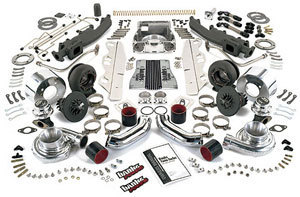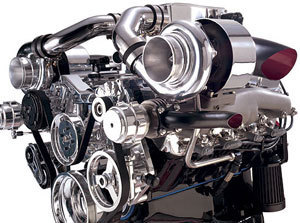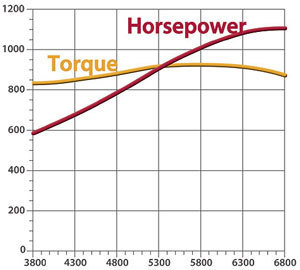Talking Turbos
Engine Masters Fall 2004
Banks Returns to the Streets with a new Twin Turbo Kit
The turbocharger has long been recognized as the most efficient form of supercharging. Without the need for a belt or any other parasitic element to rob precious power, the exhaust-driven turbo is capable of providing boost for a minimal power price. The downside of running a turbo is normally limited to the cost (turbos must be capable of living in a harsh environment at high temperatures, which means top-notch materials, and they are pricey) and actual installation issues. Because turbos work best when installed close to the exhaust ports (to take advantage of the greatly-expanding heat present to help spin the turbo), custom plumbing is usually the rule. This fabrication can become costly when a custom-built setup is required to fit the turbo(s) in place.
Gale Banks Engineering first developed a twin-turbo kit for the street over 20 years ago. That particular kit used a custom-calibrated carburetor in a blow-through arrangement to provide proper air/fuel mixture to the cylinders. While effective, it pales to modern technologies, and when Banks re-thought the idea of selling complete twin-turbo kits to street enthusiasts, several upgrades were deemed appropriate.

Banks’ turbo kits are very complete. Since Banks offers complete engines, they know what it’ll take to complete an upgrade. Note the custom exhaust manifolds and their specially-designed stainless gaskets, and the completeness of the hardware and gasket inventory for this kit. It really does include everything you’ll need, including help! Banks has a technical assistance line to help with any issues that may arise.
Firstly, electronic fuel injection was deemed essential. With the ability to program the fuel and timing to maximize efficiency at all boost levels, the turbo system gained critical reliability and fuel efficiency. Unlike a carb (which is limited to jetting), EFI offers wide tuning parameters based on the needs of the engine at any time. Whether it’s pulling hard off the line and making peak horsepower or easing down the freeway in overdrive and maximizing fuel economy, the EFI-equipped twin-turbo can deliver dreamy street manners. Drivability is key here, and the programmable inputs simply outdo what a carb and distributor are capable of on their own.
Next came the turbochargers themselves. Materials research in the turbo world has led to some phenomenal new designs, which require less effort to make more boost while lasting longer. The advent of better quality metals, ceramics, and manufacturing methods (like advanced casting methods, CNC-machining, and extensive quality assurance checks by manufacturers) has resulted in more efficient and reliable turbochargers. The latest versions are capable of more boost with less lag, while simultaneously gaining dependability over the long haul. The latest variable-vane turbos offer even more, with the ability to change internal vane angle to better respond to driver needs. Boost comes up quicker and at a higher rate than ever before, and these technologies could only make Banks’ revamped twin-turbo kit better. With their precision-balanced inconel turbine wheel and shaft assembly, durability and reliability are never in question. The efficiency of our compressor design helps to reduce inlet air temperatures to acceptable levels, eliminating the need for an intercooler.

One of the issues often encountered with turbos is heat. By mounting theirs high and forward, Banks’ setup gets a breath of fresh air from the radiator/grill area of the vehicle, and this helps shed plenty of heat. This well-engineered setup can be fine-tuned to perform in heavy trucks or flyweight cars. The flexibility of the Accel DFI Gen VII EFI and the brutal durability Banks has engineered into his products makes for a wide spectrum of possible applications.
Further engineering resulted in more features, including a street-friendly shuttle valve. This built-in integral shuttle valve bypass prevents surge conditions and eliminates backpressure caused by the compressed air hitting closed throttle plates when shifting. Without this valve, power would be sluggish between shifts due to increased lag from slowed down turbos. With it, boost pressure can transition in sync with shifts, resulting in a smoother power transition after the gear change is complete.
As was mentioned earlier, packaging turbos is tricky. The incredibly high temperatures present require careful attention, as does the normally-complex plumbing necessary to get exhaust gases to the turbos and out again, and of course the ducting required to bring filtered air to the turbo, and then back to the intake manifold.
Turbo fiends know the critical importance of wastegates. The latest developments from Banks are called BigHead® Wastegates, and are designed for a flat boost curve resulting in an awesome power transition. The high-gain actuator allows for quicker spool-up and less boost creep. The stainless steel body withstands the high temperatures, ensuring a long and reliable service life.
These critical wastegates must also be plumbed in to relieve the excess boost present when the throttle is lifted, or when the boost level has reached its pre-determined maximum. The plumbing itself is one issue since it is necessary for the turbocharged engine to take advantage of the boosted inlet air, but making it fit and especially making it fit under the hood of a street machine is another matter.

The front drive system keeps all the necessary accessories tucked in close to the engine for adequate clearance to the turbo housing. Many hours and miles of testing has shown this setup to work wonderfully, but you’d better have a chassis capable of handling the power! Note the power steering pump and air conditioning compressor are in place and ready for duty!
While all this boost is being made and directed properly, the street enthusiast also has a need for other engine accessories to function normally, like power steering, air conditioning, and other belt-driven accessories commonly found in streetcars. Banks was able to explore other developments in the street market and became very interested in the popular new “Front Runner” accessory drive system designed and marketed by Vintage Air. This cool setup relies upon a single machined bracket, which locates all of the common accessories street enthusiasts like and powers them all with a single serpentine belt. The Front Runner setup found immediate favor with street rod enthusiasts due to its compactness and overall neatness. The top-quality of its construction and visual appeal didn’t hurt either.
When Banks fitted up his updated turbo system with a Front Runner in place, all of the necessary turbo-related hardware cleared the drive system, and the result is both beautiful and effective. There’s room to tuck the wastegates inboard of the turbos, which are also tucked in close to the powerplant thanks to Banks’ own custom-cast exhaust manifolds. The overall effect is one of visually-appealing packaging with practical application, and there’s that horsepower thing

This dyno graph shows the top-dog 1,100hp setup. This requires 100-octane unleaded gas (available at the pump in many states) and an intercooler. Banks tells us the only limit to the power potential in these engines is the octane in the gas. Extensive testing has shown where the fuel and timing need to be to crank out these huge power numbers and not run into detonation. Have you ever seen a flatter torque curve?
Banks’ twin-turbo kits for the small-block Chevy can be tailored from 600+ peak ponies on pump gas to over 1,600 hp on 100-octane racing gas. [The availability of 1,600 hp capability will be announced at a later date—Gale Banks Engineering]. The same basic components are used throughout, with minimal upgrades required to support the heavier power levels at high boost. The lower boost levels in the 600-1,000 horse packages make for very responsive engines. Boost is on tap, so lag is virtually eliminated. The turbos are capable of much more than these lower-level tune-ups are asking for, resulting in a more-instant boost with less time required to spool up (lag time).
The result of all this engineering is a modern interpretation of a proven package. With decades of experience under his belt, Gale Banks and his capable engineering team have been able to create silky-smooth streetworthy engine kits that are sold complete, but unassembled. This gives the purchaser the freedom to build either exactly as Banks has engineered them or to tailor any specific portion of the powerplant to further match their own needs. Naturally, many options are available on parts included in the kits to further cater to the specific needs of each individual customer. Banks encourages any potential purchaser to confer with his educated sales staff to ensure the best possible combination, and whether your tastes are for street, drag, road race, off-road, or almost anything else, know that a well-engineered twin-turbo small-block Chevy kit with plenty of modern innovation, reliable power, and stunning visual appeal is readily available for you.

